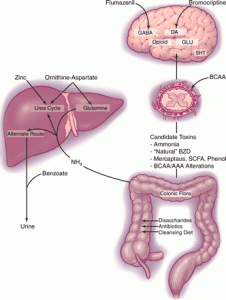 At the International Liver Congress 2013: 48th Annual Meeting of the European Association for the Study of the Liver (EASL). An abstract was presented exploring the role of probiotics in the reduction of risk for development of hepatic encephalopathy Abstract 78. Presented April 26, 2013.
At the International Liver Congress 2013: 48th Annual Meeting of the European Association for the Study of the Liver (EASL). An abstract was presented exploring the role of probiotics in the reduction of risk for development of hepatic encephalopathy Abstract 78. Presented April 26, 2013.
An open label randomised controlled trial of probiotics for primary prophylaxis of hepatic encephalopathy in patients with cirrhosis. M.K. Lunia, B.C. Sharma, S. Sachdeva, S. Srivastava. Department of Gastroenterology, G B Pant Hospital, Delhi, India.
Hepatic encephalopathy is a syndrome observed in patients with cirrhosis. Hepatic encephalopathy is defined as a spectrum of neuropsychiatric abnormalities in patients with liver dysfunction, after exclusion of other known brain disease. Hepatic encephalopathy is characterized by personality changes, intellectual impairment, and a depressed level of consciousness.
The authors describe how probiotics were effective in helping to prevent a first episode of overt hepatic encephalopathy in patients with cirrhosis, compared with patients not receiving probiotics.
Lead author Manish Lunia, MD stated “The patients in the control group had 2 times the chance of developing overt hepatic encephalopathy in the follow-up period,”
It is estimated that hepatic encephalopathy occurs in 30% to 45% of patients with cirrhosis, and the mortality rate is 20% to 30%. Because bacterial overgrowth in the small intestine (SIBO) leads to endotoxaemia, the researchers considered that probiotics may prevent the condition.

This study was constructed using an open-label, prospective, randomised trial, in which they enrolled patients 18 to 80 years of age with cirrhosis and no history of overt hepatic encephalopathy. A comprehensive set of psychometric tests, and the psychometric hepatic encephalopathy score were used to diagnose encephalopathy. Glucose hydrogen breath tests were used to identify SIBO and lactulose hydrogen breath tests were used to identify orocecal transit time.
Study participants were randomly assigned to the probiotic group (n = 86) or the control group (n = 74). The researchers used the commercially available VSL#3, which is a mixture of nonurease-producing organisms: Streptococcus thermophilus and various species of Bifidobacterium and Lactobacillus (110 billion colony-forming units, 3 times daily).
There were no significant differences between the probiotic and control groups in terms of baseline age (about 44 to 47 years), sex, cause of cirrhosis, proportion of Child–Turcotte–Pugh classes, and model for end-stage liver disease (MELD) score. The groups also did not differ in various baseline laboratory parameters, such as small intestinal bacterial overgrowth (38.4% vs 35.1%) and the proportion of patients with minimal hepatic encephalopathy, defined as a psychometric hepatic encephalopathy score of 5 or lower (48.8% and 44.6%).
Patients were followed monthly for signs of overt hepatic encephalopathy or death (mean follow-up time, 38 to 40 weeks). Every 3 months, they underwent psychometric, arterial ammonia level, critical flicker frequency, glucose hydrogen, and lactulose hydrogen breath tests. Six probiotic patients and 5 control subjects were lost to follow-up.
More patients in the probiotic group than in the control group developed overt hepatic encephalopathy (8.8% vs 20.3%). Kaplan–Meier analysis revealed a hazard ratio for developing overt hepatic encephalopathy of 2.1 (95% confidence interval, 1.31 – 6.53; P < .05). There were fewer deaths in the probiotic group than in the control group (7.5% vs 11.5%).
A significantly greater proportion of patients with Child class B and C cirrhosis than with class A cirrhosis developed overt hepatic encephalopathy, but patients with Child class A and Child class B did not differ from each other (P = .36).
Table. Child Class Effect on Development of Hepatic Encephalopathy
| Child Class of Cirrhosis | Proportion, % | P value (vs class A) |
| A | 8.3 | — |
| B | 13.0 | <.05 |
| C | 16.5 | <.01 |
In the probiotic group, there were significant improvements from baseline to 3 months in arterial ammonia (P = .04), small intestinal bacterial overgrowth (P = .006), orocecal transit time (P = .05), psychometric hepatic encephalopathy score (P = .01), critical flicker frequency test (P = .02), and minimal hepatic encephalopathy (P = .001). In the control group, there were no significant differences from baseline in any of these parameters.
Factors significantly associated with the development of overt hepatic encephalopathy were minimal hepatic encephalopathy (adjust odds ratio [aOR], 3.1), Child–Turcotte–Pugh score (aOR, 1.6), small intestinal bacterial overgrowth (aOR, 2.1), and critical flicker frequency (aOR, 1.44).
Dr. Lunia reported that 5 patients with minimal hepatic encephalopathy or 31 patients without minimal hepatic encephalopathy would need to be treated to prevent 1 case of overt hepatic encephalopathy.
Comment
This study involved patients with a low level of hepatic encephalopathy at worst, and was therefore for prevention, not treatment. This is not to be viewed as a standard of care, but it does once again open up interesting discussions relating to the role of bacterial populations on complex illness.
Large parts of this text were extracted from the Medscape website, and were compiled by Daniel M. Keller PhD for which we extend our thanks for his review.




